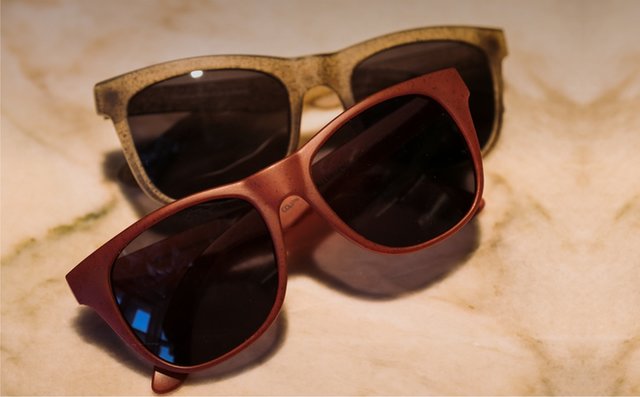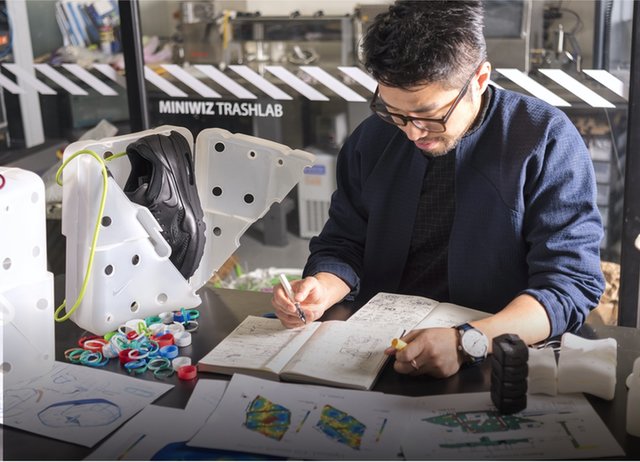ANewPhilosophy
ArthurHuangdesignsbuildingsandotherproductstohavethesmallestcarbonfootprintpossible.Thismeanshewantsaproducttoproduceaslittlecarbondioxidegasaspossiblewhenthatproductisbeingused.GuesswhatthecarbonfootprintoftheEcoArkis? Zero!
Thebuildingrunswithoutproducinganycarbondioxide.Evensystemsthatrequireelectricity,likethefans,pumps,andlights,gettheirpowerfromwindandsolarenergy,notbyburningfossil fuels.

SolarpowercapturedduringthedayrunsEcoArk’sLEDlightingsystemsat night.

HuangridesaskateboardmadefromrecycledwasteattheMiniwizofficein Taiwan.
Upcycling
TheEcoArkisjustoneexampleofhowArthurHuangturnstrashintotreasure.Heisconvincedthatmostofthewastepeopleproducecanbeusedasresourcestomakesomethingelse.Andthenewproductcanbemorevaluablethantheoriginal.Thisideaiscalledupcycling.
Toturnthisideaintoaction,HuangstartedthecompanyMiniwiz.Thenamecomesfromthecompany’smotto:“Itiswisetominimize.”Hisgoalistohelppeopleminimizetheircarbonfootprintbyusingupcycledproducts.Thatwillalsoreducetheamountofwasteintheworld,especiallyplastic.Plasticdrinkbottles,forinstance,wereupcycledtomakepolli-bricks.Thisisonlyoneofabout1,200newmaterialsMiniwizhascreatedfrom trash.
TheSky’stheLimit
Whenitcomestomaterialsandproductsthatcanbemadeofupcycledtrash,thesky’sthelimit.Literally.Miniwizhasdevelopedamaterialfromplasticwastethatisusedtomakewingsforaone-personairplane.That’soneinventionthatreallyputsthe“up”in upcycling!
WhatotherwondershavecomeoutofMiniwiz’s“trashlab?"Howaboutfurnituremadeoutofcigarettebutts—themostlittereditemintheworld?ThentherearesunglassesmadefromCDs.Anddon'tforgetsneakersmadefromupcycledplasticthatcomepackagedinaclearshoeboxthatcanberefoldedintoa backpack.

Thesesunglassesaremadefromrecycled materials.
Trashpresso
Oftenthetrickiestpartofupcyclingisfiguringouthowtodoit.Howdoyouactuallychangeplasticgarbageintoausefulmaterialorproduct?Sometimes,youhavetoinventamachineandawholenewwayofdoingthings.That’sexactlywhatthecreativemindsatMiniwiz did.

Huangdesignedshoesandtheboxtheycomeinoutof trash.

Trashpresso
Trashpressoisanassemblylineofseveralmachinesworkingtogether.Theprocessbeginsbyshreddingtheplastictrash,usuallybottles,intoflakes.Theflakesarethenwashed,dried,andplacedintomolds.Theflakesaremeltedinanovenandpressedintotheshapeofthemold.Mostoftheshapesaresix-sidedtilesthatpeoplecanusetobuildwalls,floors,orceilings,orfordecoration.Trashpressoisdesignedtohaveazerocarbonfootprint.Itdoesn’tburnfossilfuels.Instead,solarpanelscapturesunlightandturnitinto electricity.
OneofthemostimportantfeaturesofTrashpressoisthatitcangojustaboutanywhere.ThisportabilityallowsHuangtousehisinventiontoeducatepeopleeverywhereabouttheproblemofplastictrashandtoinspirethemtodowhattheycantobepartofthe solution.
Trashpresso
SHREDDER
breaksdownplastictrashintotiny flakes.
DEHUMIDIFIER
driesthewet flakes.
WORKBENCH
is whereflakesareplacedinto molds.
ELECTRICALSTATIONcontainstheelectricalsystemtomakethemachine operate.

WASHER
cleanstrashtoremove impurities.
WATERPIPING
carriesdirtywater away.
DRYER
furtherreduces moisture.
WATERTANKS
store water forthe proces.
WORKBENCH
iswhere flakesareplacedinto molds.
ELECTRICALSTATION
containstheelectricalsystem tomakethemachine operate.
AIRFILTER
preventsthereleaseoftoxicvaporsthatmightbeproducedduringthemelting stage.

DRYER
furtherreduces moisture.
WATERTANKS
store water forthe proces.
OVEN
whereflakesmeltintheirmolds,formingfinished tiles.
WATERFILTER
purifiesthewaterandcyclesthewaterbackthroughthe system.



1: SHREDDER
breaks down plastic trash into tiny flakes.
2: WASHER
cleans trash to remove impurities.
3: DEHUMIDIFIER
dries the wet flakes.
4: WATER PIPING
carries dirty water away.
4: DRYER
further reduces moisture.
5: WORK BENCH
is where flakes are placed into molds.
5: WATER TANKS
stores water for the process.
6: ELECTRICAL STATION
contains the electrical system to make the machine operate.

6: AIR FILTER
prevents the release of toxic vapors that might be produced during the melting stage.
6: OVEN
where flakes melt in their molds, forming finished files.
6: WATER FILTER
purifies the water and cycles the water back through the system.
CIRCULARECONOMY
Mosteconomiestodayarelinear.Thismeansresourcesareusedtomakeaproduct.Theproductisusedandthenthrownaway,producingwasteandpollution.Butinacirculareconomy,wasteisusedasaresourcetomaketheproductagainortomakeanotherproduct.Sotherereallyisnosuchthingaswasteinacircular economy.
recycle
make
use
reuse
remake
CIRCULARECONOMY
